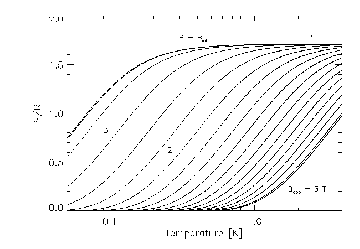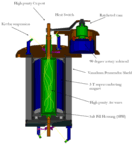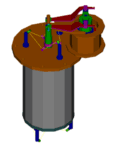Because
the MSAM2 detectors are optimized for single-mode operation
in the microwave waveguide, they require cooling to about
100 mK to achieve their best sensitivity. In order to
do this for flight, we use an adiabatic demagnetization
refrigerator (ADR).
An ADR cools a sample using the magnetic field dependence
of the entropy of a paramagnetic salt. We use ferric ammonium
alum (FAA) as our refrigerant. Starting from a pumped
helium bath temperature of 1.4 K, it is possible to achieve
temperatures as low as 40 mK with an FAA ADR - or, by
controlling the magnetic field applied to the salt, to
maintain a selected temperature between 40 mK and 1.4
K with great accuracy.

Figure 1
Figure
1 shows the family of entropy versus temperature curves
for FAA along with the cooling cycle (paths 1,2, and
3) of our refrigerator.
Here
are the specifications for our ADR.
| Salt
|
Ferric
Ammonium Alum |
| Salt
Mass |
113
g |
| Salt
Volume |
51
cc |
| Cv
(parasitics) |
59.14T
+ 0.035T2 [J/K] |
| Thermal
Time Cnst. |
51
s |
| Heat
Switch |
Internal
Mechanical |
| Duration
of Cycle |
2.4
ks |
| Quiescent
Thermal Load |
0.97
uW |
| Cooling
Capacity at 100 mK |
134
mJ |
| Hold
Time at 100 mK |
138
ks |
| Duty
Cycle |
98.3% |
Using
our FAA ADR - a recyclable refrigerator - we have demonstrated
the ability to achieve an operating temperature of 100
mK for 138,000 seconds with a duty time of greater than
98%.
|

Figure
2.
|

Figure
3.
|
Figure
2 and Figure 3 show the completed ADR assembly.

Figure 4
|

Figure 5
|
Figure
4 and Figure 5 shows the main
parts of this assembly.
Single
and double stage ADRs promise to be the future of low
background and space-based cryogenics. Having demonstrated
an ADR which is remotely operable opens the door to
purely electrical refrigeration on future balloon and
satellite platforms - eliminating the cost and inconvenience
of cryogens in gravity-free environments.
While ADRs have been in use since the early part of
the 20th century, people have traditionally shied away
from their use due to the perceived difficulty in growing
the paramagnetic salt. We have developed a novel growing
technique which allows for strict control over the solute/solvent
temperatures and which consistently results in salt
pill housings filled to 99% capacity. The simplicity
of this technique allows for mass production of FAA
salt pills with a production time of only a few weeks.
In addition, we have created a new internally driven
mechanical heat switch used to make and break thermal
contact to the ADR. This heat switch sits on the 1.4
K plate and can be operated remotely with a short pulse
of current. This switch has proven to be extremely robust
and reliable - having run without a problem during two
balloon flight campaigns.
We are very pleased to see that many groups are now
developing ADRs with FAA stages baselined from our designs
and grown using our techniques. Examples include John
Martinis at NIST who has taken the ADR concept one step
further by adding a high temperature GGG stage to the
design, the XRS satellite team who have contacted members
of our group about ways to improve the robustness of
their own ADR design, and a new collaboration between
Joshua Gunderson and Janice Research Instruments to
mass market dual stage ADRs.